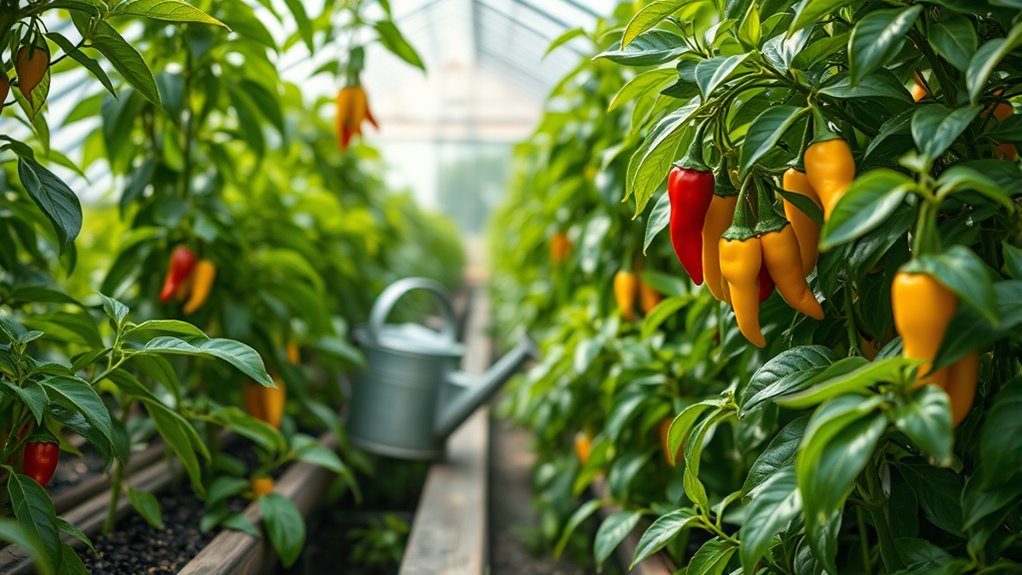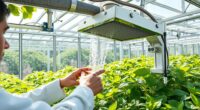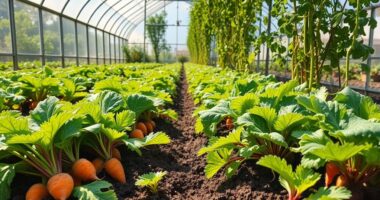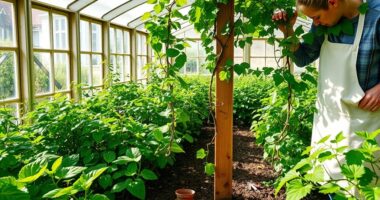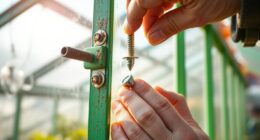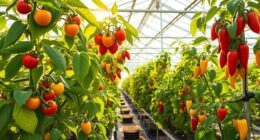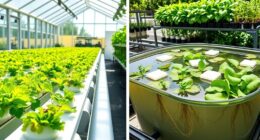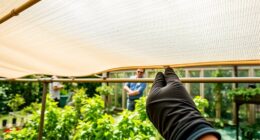To grow peppers successfully in a greenhouse, keep daytime temperatures between 21-26°C and guarantee you have six to eight hours of direct sunlight daily. Select disease-resistant and high-yield varieties, and plant them in nutrient-rich soil with a pH of 6.0-7.0. Maintain consistent moisture and consider using vertical supports for airflow. Regularly check for nutrient deficiencies and adjust accordingly. By following these tips, you'll boost your pepper yields and quality. Discover even more techniques to enhance your greenhouse gardening!
Key Takeaways
- Maintain optimal temperature in the greenhouse, ideally between 21-26°C during the day and 18-21°C at night for healthy pepper growth.
- Ensure peppers receive at least six to eight hours of direct sunlight daily; consider supplemental lighting if natural light is insufficient.
- Use a well-draining soil mix with a pH of 6.0-7.0, incorporating compost for nutrient-rich growing conditions.
- Implement a consistent watering schedule, providing 1-2 inches of moisture weekly while monitoring soil humidity levels.
- Utilize vertical supports to manage plant height and promote air circulation, reducing the risk of mold and disease.
Ideal Conditions for Growing Peppers
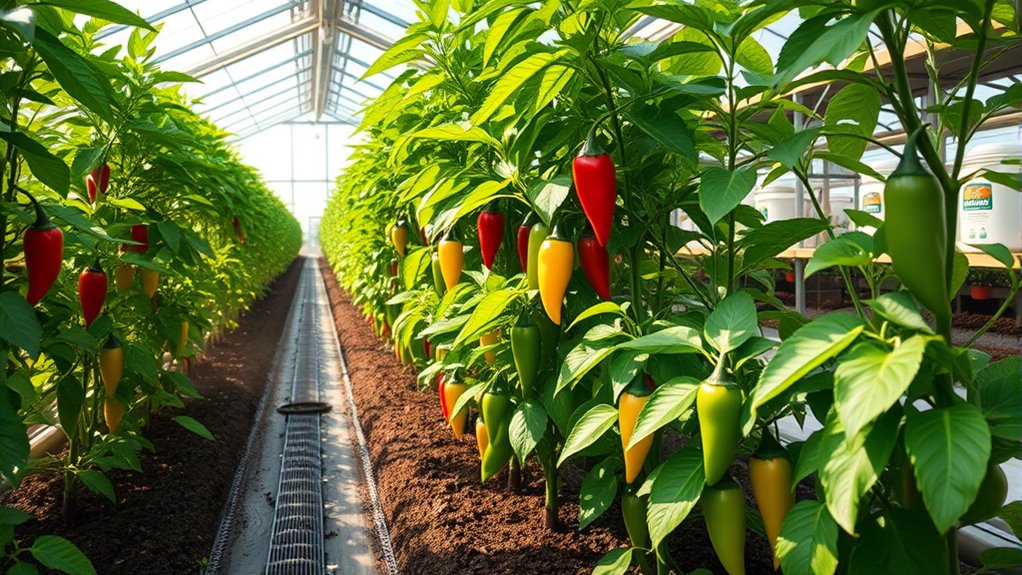
To successfully grow peppers, you need to create ideal conditions that cater to their specific requirements. Start by confirming daytime temperatures range from 21-26°C (70-80°F) and nighttime temperatures stay between 18-21°C (65-70°F).
Creating ideal conditions for growing peppers involves maintaining specific daytime and nighttime temperature ranges.
For seed germination, maintain soil temperatures between 23-29°C (75-85°F). Aim for relative humidity between 65-85% and a Vapor Pressure Deficit (VPD) of around 0.5-1.0 kPa to promote healthy growth and prevent disease.
Provide at least six to eight hours of direct sunlight daily, and consider using artificial lighting when natural light is low.
Finally, monitor your soil pH, aiming for 6.0-7.0, and confirm consistent moisture levels to support robust pepper development.
Selecting the Right Pepper Varieties
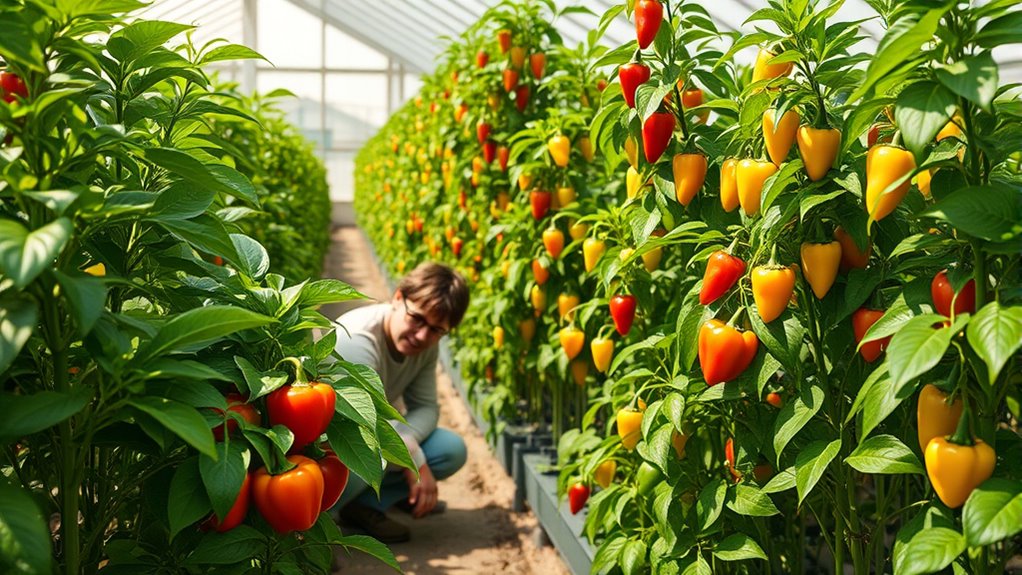
Creating the right environment for peppers lays the groundwork for selecting the best varieties. Focus on disease-resistant options, like 'Brocanto', to combat common issues.
Look for plants with a vigorous growth habit to guarantee strong foliage and fruitful yields. Choose blocky or bell-shaped peppers for their uniformity and ease of handling, enhancing your market appeal.
Consider high-yielding varieties like 'Francelia' and 'Triple 5' for consistent production. Don't forget flavor; varieties such as 'Sprinter' can boost your sales.
Adaptability is key, so opt for peppers like 'Eurix' that perform well under various conditions. Finally, stay informed about market preferences to guarantee your selections align with consumer demands.
Planting Techniques for Optimal Growth
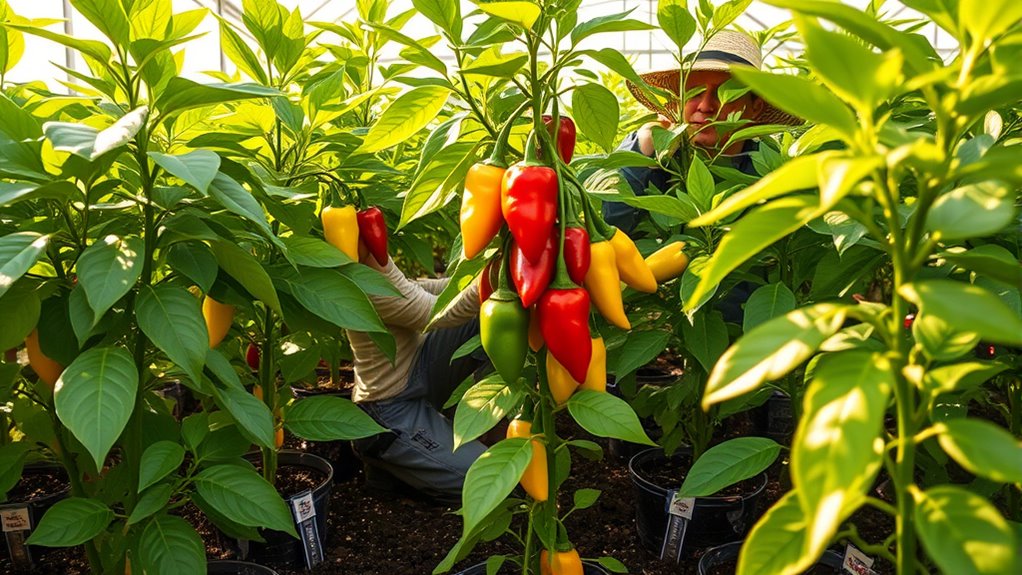
While you might be enthusiastic to get your peppers in the ground, understanding the right planting techniques is essential for achieving ideal growth.
Start by ensuring your soil temperature stays between 80–90°F (27–32°C); this is vital for root development. Use nutrient-rich soil with a pH of 6.0 to 7.0, incorporating compost to enhance moisture and nutrients.
Space your plants 18-24 inches apart to promote airflow and reduce disease risk. Aim for at least 6-8 hours of sunlight daily, and consider using vertical supports like trellises.
Finally, establish a consistent watering schedule, providing 1-2 inches of water weekly, and monitor soil moisture to avoid stress. Following these techniques will set your peppers up for success.
Germination Essentials for Pepper Seeds
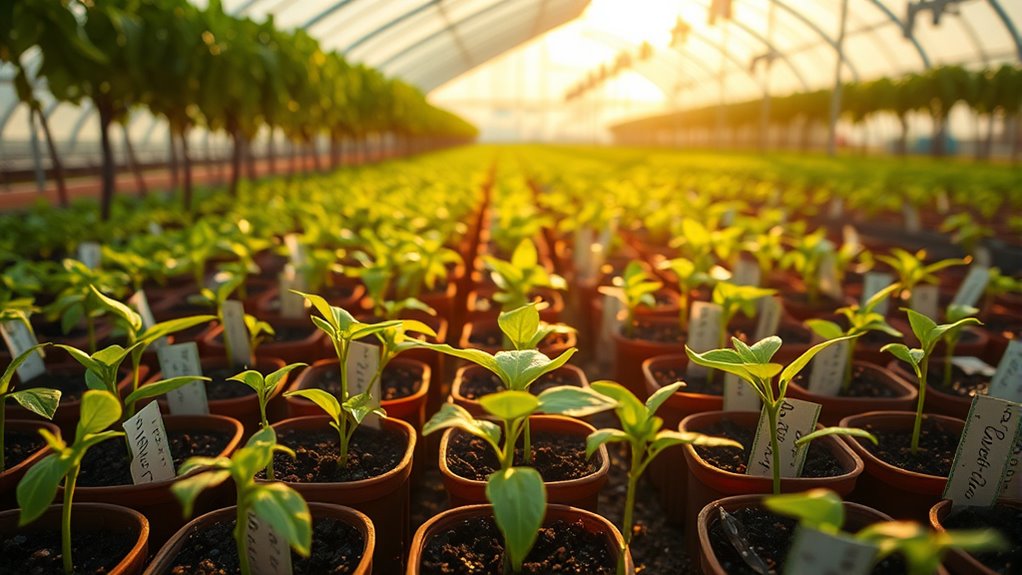
Germinating pepper seeds successfully demands careful attention to their specific needs. Start by ensuring the soil temperature stays between 80°F and 85°F, using a seedling heat mat for consistent warmth. Protect your seeds from drafts and temperature swings.
To maintain humidity, cover them with a clear plastic dome or humidity bag. Choose fresh, plump seeds and consider soaking them beforehand to enhance germination. Use a sterile, well-draining seed starting mix with a neutral pH of around 6.5.
Keep moisture levels even but avoid overwatering, ensuring good drainage. Be patient, as germination typically takes 1 to 3 weeks, and remember that some varieties may take longer to sprout, so timing is essential for healthy seedlings.
Nutrient Requirements and Fertilization
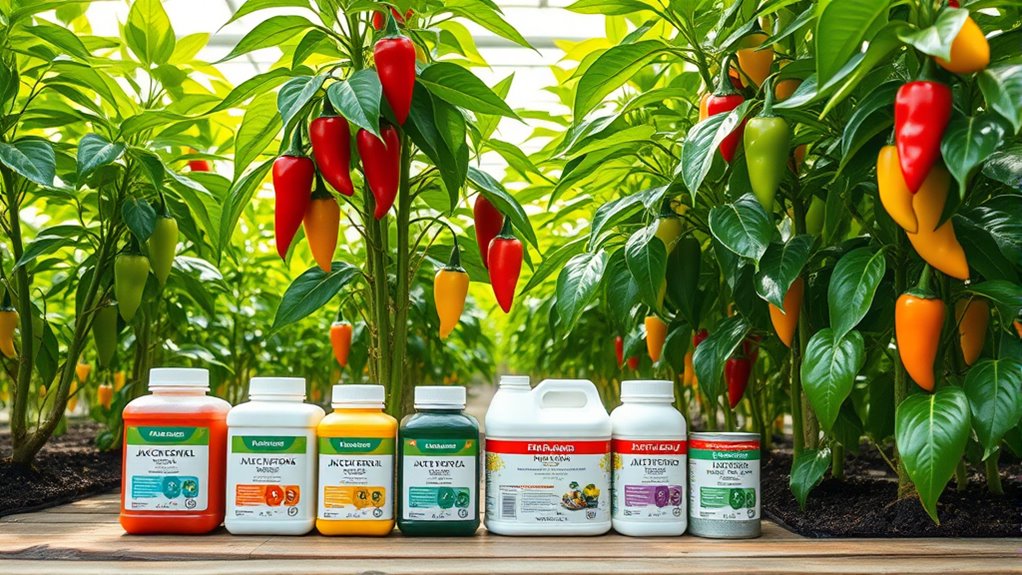
To guarantee robust growth and abundant fruiting, understanding the nutrient requirements of pepper plants is crucial. You need to focus on five key nutrients: nitrogen, phosphorus, potassium, calcium, and sulfur.
Nitrogen supports vegetative growth, while phosphorus aids root development and fruit ripening. Potassium enhances sugar transport and disease resistance. Calcium strengthens cell walls, reducing disease susceptibility, and sulfur is essential for amino acid synthesis.
For peak results, apply fertilizers regularly, particularly during fruiting. Confirm at least 50-90% of nitrogen is in nitrate form for better uptake.
Watch for deficiencies: nitrogen slows growth, phosphorus leads to weak roots, and potassium increases disease risk. Maintain soil pH between 6.0 and 7.0, and avoid over-fertilization to promote healthy fruit formation.
Managing Pests in the Greenhouse
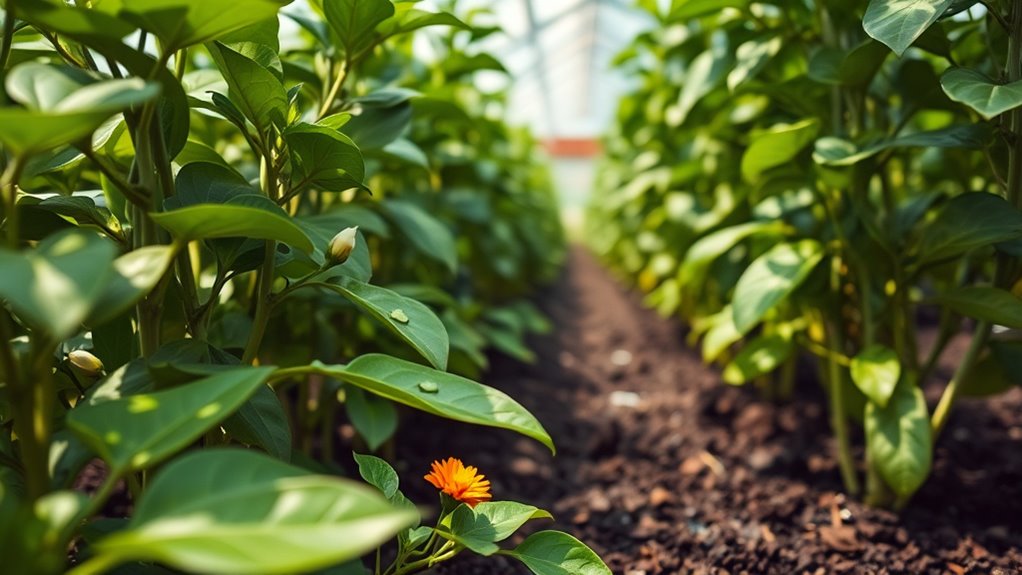
Managing pests in the greenhouse is essential for ensuring healthy pepper plants and maximizing your yield. Common pests like aphids, whiteflies, spider mites, and thrips can harm your plants, so keep a close eye on them.
Install insect screens to prevent pests from entering, and use strong water sprays to dislodge any that do. Insecticidal soaps can provide immediate relief, while introducing beneficial insects helps control populations naturally. Sticky traps are great for monitoring pest activity.
Regularly inspect plants and set up scouting patterns to catch issues early. Remember, maintaining cleanliness and proper climate conditions can deter pests, making your greenhouse a thriving environment for your peppers.
Stay proactive, and you'll enjoy a bountiful harvest!
Preventing Diseases in Pepper Plants
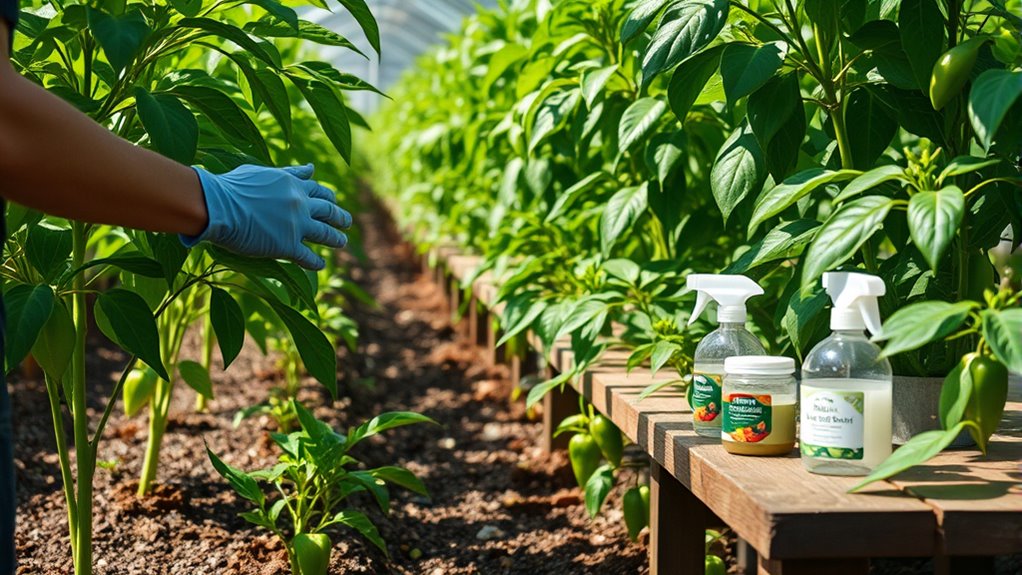
While growing peppers can be rewarding, preventing diseases is essential to ensuring healthy plants and a bountiful harvest. Start by closely examining your plants for symptoms like wilting, yellowing leaves, and brown lesions, which can indicate issues like root rot or foliar blights caused by pathogens such as *Phytophthora capsici*.
To minimize risks, prepare well-draining soil with a pH between 6.0 and 7.0, and incorporate organic matter. Manage irrigation carefully to avoid waterlogging, and consider using drip irrigation. Rotate crops and select disease-resistant varieties to further prevent recurring problems.
Finally, maintain cleanliness in your greenhouse and apply organic fungicides as needed for effective control. Regular monitoring is key to catching diseases early.
Harvesting Tips for Peppers

After taking steps to prevent diseases in your pepper plants, it's time to focus on harvesting those vibrant fruits.
Look for peppers that have reached their full color, whether that's green, yellow, orange, or red, depending on their variety. Fully ripened peppers not only taste better but also pack more heat if they're hot varieties.
Look for fully ripened peppers in their vibrant colors for the best flavor and heat, tailored to each variety.
Harvest regularly to encourage more fruit production. Use shears or a sharp knife to cut the peppers, leaving a small piece of stem attached to avoid moisture entering the fruit.
Aim to harvest in the morning when peppers are firmest. Handle them gently to prevent bruising, and remember that small-fruited varieties can be picked in clusters while larger ones should be harvested individually.
Post-Harvest Care and Storage

Once you've harvested your peppers, it's important to handle them properly to maintain their quality and freshness. Start by cooling them quickly using forced air cooling, as this helps prevent spoilage. Avoid hydrocooling, since liquids can infiltrate the fruit.
Store your peppers in a cool, dry environment, ideally in the refrigerator, to prolong their shelf life. Handle them gently to avoid bruising and damage, and sort and pack them immediately after harvesting to maintain quality.
Regularly inspect your stored peppers for signs of spoilage and keep them dry to control moisture. If you have excess peppers, consider drying, freezing, or pickling them to extend their usability while preserving flavor and texture.
Ensuring Year-Round Production

To guarantee year-round production of peppers in your greenhouse, it's crucial to maintain ideal growing conditions throughout the seasons.
Keep daytime temperatures between 21-26°C (70-80°F) and nighttime temperatures at 18-21°C (65-70°F) to prevent blossom drop. Use heating systems like heat mats to make certain soil temperatures stay around 23-29°C (75-85°F) for germination.
Maintain daytime temperatures of 21-26°C and nighttime temperatures of 18-21°C to ensure healthy pepper growth and prevent blossom drop.
Provide 6-8 hours of direct sunlight, and space your plants 12-24 inches apart for best growth.
Invest in vertical supports to manage height and fruit load, while making sure to have adequate air circulation to combat mold.
Regularly test your soil, maintain a pH of 6.0-7.0, and use quality organic fertilizers to keep your peppers flourishing all year long.
Frequently Asked Questions
How Do I Choose the Right Greenhouse Size for Peppers?
When choosing the right greenhouse size for peppers, consider your space and how many plants you want to grow.
Aim for at least 18 inches between each plant for ideal growth.
Think about future expansion—if you plan to grow more varieties later, select a larger size.
Keep budget constraints in mind, making sure you can maintain the greenhouse effectively.
Finally, verify there's enough room for accessing and caring for your plants easily.
Can Peppers Be Grown Vertically in a Greenhouse?
Absolutely, you can grow peppers vertically in a greenhouse!
It's like giving your plants a lovely little skyward adventure. By utilizing trellises or stakes, you'll see your peppers thrive while saving space.
With the right light, temperature, and nutrients, those vibrant colors will shine brightly, creating a delightful spectacle.
Plus, vertical growth can boost your yields and reduce the risk of pests.
Isn't that a charming way to cultivate your garden?
What Companion Plants Benefit Pepper Growth in a Greenhouse?
Companion plants like marigolds, basil, and cilantro can really benefit your pepper growth.
Marigolds attract beneficial insects and deter pests, while basil enhances flavor and draws pollinators.
Cilantro not only attracts helpful insects but also repels spider mites and aphids.
Incorporating carrots and beans can improve soil health, helping your peppers thrive.
How Can I Extend the Growing Season for Peppers?
Did you know that using row covers can increase your harvest by up to 30%?
To extend your growing season for peppers, consider using row covers to protect against frost. You can also apply plastic mulch to warm the soil, promoting earlier growth.
High tunnels provide extra warmth and protection, while grow lights guarantee your plants get enough light during colder months.
Insulating your greenhouse will help maintain warmth during winter, too.
What Are the Signs of Nutrient Deficiency in Pepper Plants?
When you notice signs of nutrient deficiency in your pepper plants, pay attention to specific symptoms.
Yellowing or paling leaves usually indicate nitrogen or iron deficiency. Look for browning, necrosis, or black spots on fruits, which could signal calcium deficiency.
Stunted growth and deformed leaves might point to other nutrient issues. Monitoring these signs helps you address deficiencies early, ensuring healthier plants and better yields in your garden.
Conclusion
As you nurture your pepper plants, think of them as vibrant jewels in your greenhouse treasure chest. By providing the right conditions and care, you're not just growing peppers; you're cultivating a bountiful harvest that reflects your dedication. With each colorful fruit you pick, you're reminded of the journey from seed to table. Embrace the rhythm of their growth, and let your greenhouse become a sanctuary of flavor, creativity, and year-round abundance.
